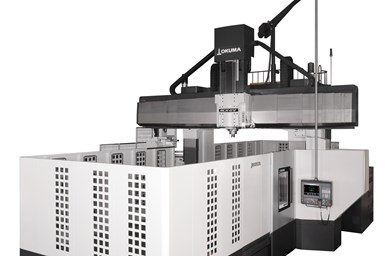Okuma Launches New Double-Column Machining Center
Okuma’s MCR-BV is capable of five-axis contouring and five-sided heavy milling applications. The company says these heavy-duty applications are made possible through the machine’s powerful integral motor and spindle, as well as an expanded work envelope.
Share


Hwacheon Machinery America, Inc.
Featured Content
View More




Takumi USA
Featured Content
View More
Okuma America Corporation has debuted a new double-column machining center (DCMC). This new machine – the MCR-BV – is the seventh machine offered in the company’s double-column machine line-up.
Designed as a machine for five-face machining applications, the MCR-BV is also reportedly capable of five-axis contouring as well as five-sided heavy milling applications. Okuma says these heavy-duty applications are made possible through the machine’s powerful integral motor and spindle, an expanded work envelope and a rigid table that is 30% thicker than previous models. A range of attachment heads are compatible with the machine, enabling for a wide range of unique part shapes to be created, as well as many multitasking machining functions to be performed.
The MCR-BV features a table size of 2,000 mm × 4,000 mm (78.74" x 157.48") to 3,000 × 12,000 (118.11" × 472.44"), as well as a spindle speed of 6000 min⁻¹ (a 10,000 min⁻¹ option is also available). The spindles have a motor power of 43 kW (57 hp), and the MCR-BV’s rapid traverse is: X: 30 m/min (98.43 fpm), Y: 32 m/min (104.99 fpm), Z: 15 m/min (49.22 fpm). In addition, the machine has a magazine capacity of 50, 80, 100, 120 or 180 tools.
Additional machine features include a fast automatic tool changer (ATC) and a smaller, faster auto attachment changer (AAC), both of which are said to enable the MCR-BV to increase productivity while performing heavy cutting or high-accuracy finishing.
Related Content
-
The Future of High Feed Milling in Modern Manufacturing
Achieve higher metal removal rates and enhanced predictability with ISCAR’s advanced high-feed milling tools — optimized for today’s competitive global market.
-
Form Tapping Improves Tool Life, Costs
Moving from cut tapping to form tapping for a notable application cut tooling costs at Siemens Energy and increased tool life a hundredfold.
-
The Impact of Cutting Teeth Spacing on Machining Stability
Many cutter designs are available, and variable teeth spacing (or variable pitch) cutters can be used to influence milling stability. Let’s discuss why teeth spacing affects stability.



































.jpg;maxWidth=300;quality=90)

